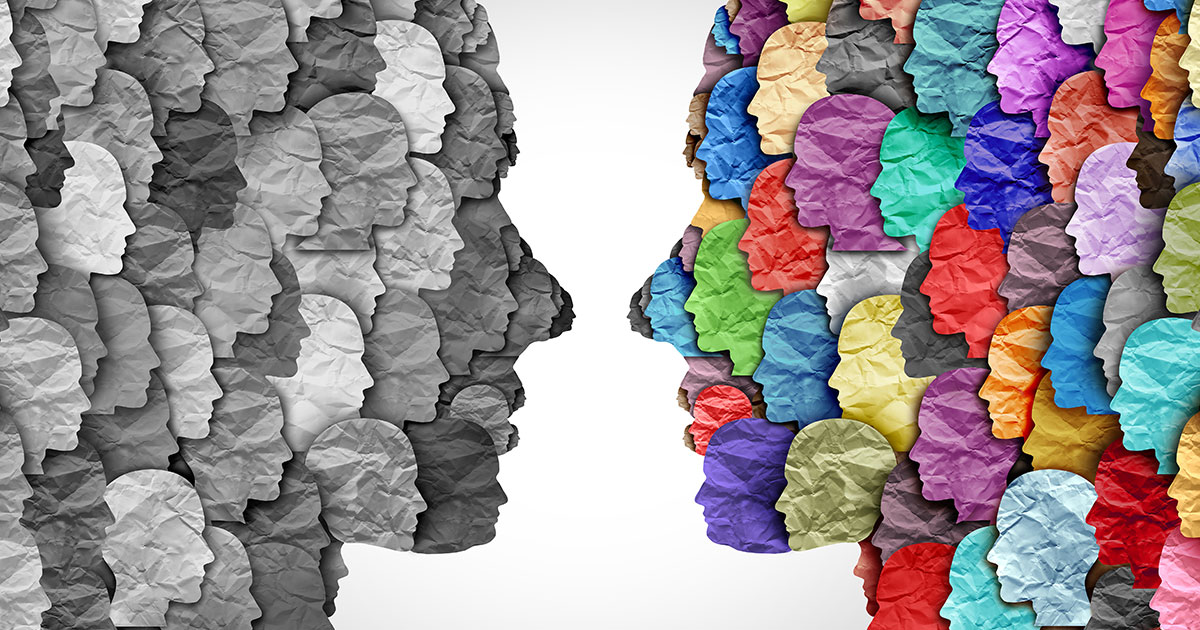
Dear Friends,
Several years back, I wrote my first published article on lawyer well-being. I shared it with a trusted friend and former colleague, who is a Black woman lawyer. She thought the article was nicely done but missed the mark in that I neglected to address the effects of diversity, equity, and inclusion (DEI)1 on one’s well-being. Her comment stayed with me for years and while I began to explore this content on my own and with family, I held back publicly – until now.
I refrained from speaking or writing about this topic because I thought, as an upper-middle-class, privileged white woman, what did I know about the effects of racism, discrimination, or daily microaggressions? Yes, as a woman, I’ve faced harassment, misogyny, and sexism in the workplace, but I don’t possess the lived experience of historically underrepresented people. While I’m not a DEI expert, I am an expert in well-being, emotional intelligence, and positive psychology. As a thought leader in this space, I felt called to begin an honest dialogue on this topic and share it with my peers.
The 2017 American Bar Association Report on Lawyer Well-Being (the national report) and Wisconsin’s report issued by the Task Force on Wisconsin Lawyer Well-Being (the Wisconsin report) both acknowledged the link between well-being and DEI. The national report discussed the negative effects of a lack of inclusivity, with research indicating a compelling link between a low sense of belonging and depressive symptoms.2 The Wisconsin report rightly noted that “[e]mbracing lawyers with different backgrounds, skills and abilities is a prerequisite to a thriving bar….”3 However, for the most part, DEI initiatives in the workplace (the legal industry included) are generally strategically planned and implemented separately from employee health and wellness programs.4
Research shows that “failing to address the intersectionality of DEI and well-being” has serious consequences:
[Killings by law enforcement officers] contribute to 1.7 additional poor mental health days for Black Americans compared to their white counterparts.
American Indian or Alaska Native (AIAN) people are more than twice as likely to be uninsured, leaving many without access to health care. Consequently, AIAN people have a higher prevalence of many chronic health conditions than [do people] from any other racial or ethnic group.
LGBTQ folks are 2.5 times more likely to experience depression, anxiety, and substance misuse than non-LGBTQ individuals, yet they face significant discrimination in health care that leads them to avoid care, putting their health at risk.5
In the last decade, against the backdrop of Dobbs v. Jackson Women’s Health Organization, continued disagreements about immigration into the United States, the #MeToo movement, the global pandemic, LGBTQ+ advocacy, and conversations and arguments nationwide about racial justice, there is no better time than this moment to examine our own thoughts, feelings, and behaviors on these topics.
Rather than tackle the systemic transformation required for change to occur, I’m writing this article so that readers can consider what they can do on an individual basis.
Three Things We Can Do Right Now
1) Acknowledge, Accept, and Appreciate. A DEI officer at an AmLaw 200 firm suggested that people acknowledge, accept, and appreciate the truth of racial trauma. For example, she shared that Black people experience trauma about incidents such as the beating by police officers and death of Tyre Nichols and the constant replays on nonstop news coverage of such stories. Then, they come into work and encounter insensitivity, implicit bias, or microaggressions from coworkers, which, in turn, exacerbate their feelings of stress, fear, and anxiety.
 Julie Bonasso, Temple 1995, is a consultant and coach specializing in lawyer well-being. An experienced corporate lawyer and Master Certified Coach, she helps clients integrate self with career to accelerate growth. The cornerstone of her coaching is leveraging well-being as the pathway to success. She is the founder and CEO of Julie Bonasso Coaching and a member of the State Bar of Wisconsin Task Force on Lawyer Well-Being.
Julie Bonasso, Temple 1995, is a consultant and coach specializing in lawyer well-being. An experienced corporate lawyer and Master Certified Coach, she helps clients integrate self with career to accelerate growth. The cornerstone of her coaching is leveraging well-being as the pathway to success. She is the founder and CEO of Julie Bonasso Coaching and a member of the State Bar of Wisconsin Task Force on Lawyer Well-Being.
She recommended avoiding questions such as, “How can I help?” or “Are you okay?”, which can create unintended additional pressure on the recipient.
Better responses include the following: “No need to respond, but I am here if you need to talk or want someone to listen.”6 Or one could say, “I would like to support you by…” and provide some tangible way to assist (for example, offer to take the lead in an upcoming meeting).7
Recognize that saying something is better than saying nothing.
2) Embrace Discomfort. Mike Bully, market director at Humana, believes people have made progress against racism and are moving in a positive direction. He noted that although it feels supportive when people are helpful immediately after a news event that involves social justice, he would like to see more allyship on a continuous basis. Given that racial discrimination has been part of history for hundreds of years (if not longer), a one-time show of support, however well-meaning, is not enough for real change, Bully said.
He suggested that we “get comfortable being uncomfortable. Keep the conversation going, take consistent action and embrace your own discomfort in discussing these topics.”
People who look like me are part of the dominant group in society. Because of privilege and power, generally people in the dominant group think we have a “right to emotional and psychological” safety, so we take a lot of time (and space) to process our emotions and overanalyze until we feel secure. For example, I hesitated on publishing this article for years because I wanted to be comfortable before broaching the topic. Waiting a long time to speak can cause unintentional harm even if intentions are good.8
3) Educate Yourself. Lindsay Bernhagen, a DEI consultant and learning strategist at Torch, said that people in the dominant group should undertake the responsibility to inform themselves on the topics of racism, discrimination, and bias. When people in the dominant group ask historically underrepresented people to teach them, Bernhagen said, people in the dominant group put additional “emotional and cognitive labor on [historically underrepresented people]. It’s not their job to bring us up to speed.”
Bernhagen further explained that one part of the process is to recognize that people move through the world in different types of bodies (whether because of a physical disability, body size, socioeconomic class, gender, or something else), which leads to vastly different experiences. This isn’t about being empathic. I initially thought that showing empathy was a good starting point. Although it can be, empathy alone can be “grossly inadequate. The differences in power dynamics disallow individuals to truly put themselves in another’s shoes or understand their lived experiences. These power dynamics are exacerbated when people interact with individuals who have significantly diverse lives because of intersections of race, gender or socioeconomic status, among others.”9
Being effective allies and advocating for change require going on a journey of self-study to understand the things we need to learn and unlearn.10 Read books and articles about people from other cultures, races, religions, genders, and socioeconomic status, people with disabilities, and other diverse individuals and groups to educate yourself on those who are not like you. Watch movies and shows that depict lives distinct from your own experience. Listen to podcasts and interviews of people with viewpoints that are significantly different from yours. Attend quality DEI training on a regular basis.
There are reasons for people’s attitudes: They have served us in some way, we were unaware of their ramifications, or we’ve been taught to behave and think in a certain way. But now that we know more, we can do more. As the Chinese philosopher Lao Tzu said, “The journey of a thousand miles begins with one step.”
What is your one step?
With love, Julie
Embark on a Journey of Self-study
Being an effective ally and advocating for change involve going on a journey of self-study to understand the things you need to learn and unlearn. Here are some additional resources:
White Fragility: Why It’s So Hard for White People to Talk About Racism, Robin D’Angelo
How to be an Antiracist, Ibram X. Kendi
How the Word is Passed, Clint Smith
Read This to Get Smarter: About Race, Class, Gender, Disability & More, Blair Imani
This Chair Rocks: A Manifesto Against Ageism, Ashton Applewhite
No Pity: People with Disabilities Forging a New Civil Rights Movement, Joseph P. Shapiro
Covering: The Hidden Assault on Our Civil Rights, Kenji Yoshino
What We Don’t Talk About When We Talk About Fat, Aubrey Gordon
I recognize I am just scratching the surface in one 1,500-word article and that there are many historically underrepresented groups I did not address in this letter. My sincere apologies.
Endnotes
1 DEI as used in this article is intended to comprise diversity of race, ethnicity, nationality, sex, gender identity and gender presentation, sexual orientation, disability, neurodiversity, family needs, age, class and socioeconomic background, individuals of different sizes, and religion.
2 ABA Law Practice Division et al., The Path to Lawyer Well-Being: Practical Recommendations for Positive Change 16 (Aug. 14, 2017), www.americanbar.org/content/dam/aba/images/abanews/ThePathToLawyerWellBeingReportRevFINAL.pdf.
3 Task Force on Wisconsin Lawyer Well-Being, Lawyer Well-Being: Changing the Climate of Wisconsin’s Legal Profession 29 (Dec. 2021), www.wisbar.org/formembers/wislap/pages/wisconsin-lawyer-well-being-task-force.aspx.
4 Katrina Lee, Solving for Law Firm Inclusion: The Necessity of Lawyer Well-Being, Vanderbilt J. Ent. & Tech. L. (Winter 2022), https://scholarship.law.vanderbilt.edu/cgi/viewcontent.cgi?article=1572&context=jetlaw.
5 Chris Michalak & Marlette Jackson, Supporting the Well-Being of Your Underrepresented Employees, Harvard Bus. Rev. (March 4, 2022), https://hbr.org/2022/03/supporting-the-well-being-of-your-underrepresented-employees [behind a paywall for some readers].
6 Tiffany Dockery, Please Stop ‘Just Checking In’ on Your Black Co-Workers (June 1, 2020), https://zora.medium.com/please-stop-just-checking-in-on-your-black-co-workers-d531f8d670a6 [behind a paywall for some readers].
7 Michalak & Jackson, supra note 5.
8 A Tool for White People Navigating Conversations About Race, https://urj.org/sites/default/files/2022-08/toolforwhitepeoplenavigatingconversationsaboutracejune2020.pdf (last visited March 1, 2023).
9 All Together, Empathy: The First Step Towards Inclusion (July 14, 2020), https://alltogether.swe.org/2020/07/empathy-first-step-towards-inclusion/.
10 Courtney Conley, 5 Ways to Start Being a Better Ally for Your Black Coworkers (June 3, 2020; updated Jan. 12, 2021), www.cnbc.com/2020/06/03/how-to-be-a-better-ally-for-your-black-coworkers.html.
» Cite this article: 96 Wis. Law. 41-43 (April 2023).
